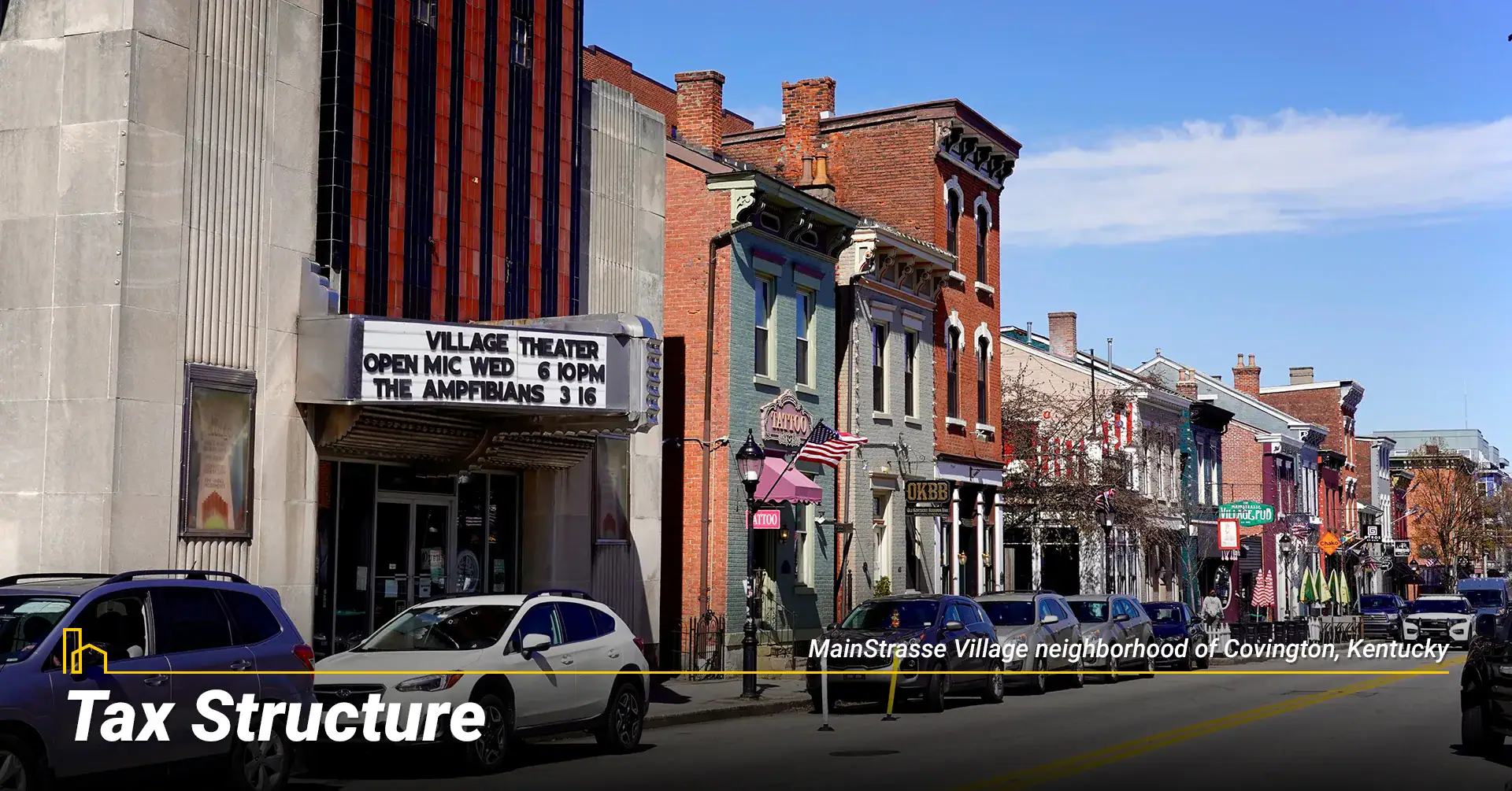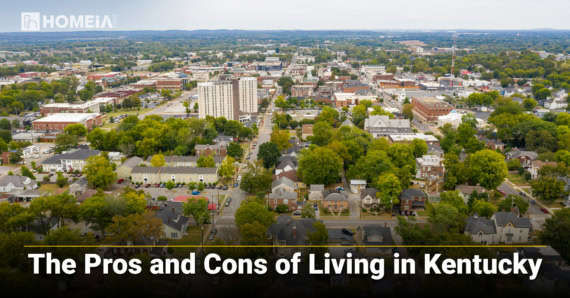Moving to Kentucky: The Complete Relocation Guide & Checklist
- Local Editor:Local Editor: Jill Mai
Published: Sep 11, 2025
- Category: City Living Guide
Nestled between the Ohio River and Appalachian foothills, Kentucky offers an attractive blend of urban convenience and rural charm that draws newcomers nationwide. About 4.5 million residents call the Bluegrass State home, attracted by its distinctive character, genuine affordability and welcoming communities. Louisville and Lexington anchor vibrant urban life with cultural attractions and career opportunities, while hundreds of charming small towns dot the landscape among rolling horse farms and wooded hills.
Known for bourbon distilling and the legendary Kentucky Derby, Kentucky offers much more to newcomers—an exceptionally affordable cost of living, a diversified and growing job market, abundant recreational opportunities, and genuine Southern hospitality. This comprehensive guide about moving to Kentucky covers essential relocation information, from local culture and climate patterns to housing markets and legal requirements.
Key Takeaways
- Affordable living: Kentucky’s cost of living runs 8 percent below the U.S. average, with housing costs 23 percent lower. Median home value sits around $355,000, while median rent averages $1,100 monthly.
- Four distinct seasons: Experience humid summers (mid-60s to mid-80s), crisp falls, mild winters (20s to 40s) and refreshing springs. The state receives 50 inches of rainfall and enjoys 190 sunny days annually.
- Diverse economy: Manufacturing, healthcare, logistics, agriculture and bourbon drive stability. Unemployment fell below 5 percent in mid-2025, with average weekly earnings near $1,050.
- Strong education: Kentucky supports 1,400+ public schools with 91 percent graduation rate and 16:1 student-teacher ratio. Crime rates remain among the region’s lowest.
- Rich culture: The state blends bluegrass music, horse racing and bourbon heritage with year-round festivals, college sports and outdoor adventures.
The Pros and Cons of Living in Kentucky
Whether you’re looking for exciting city life, suburbs to raise a family, or a little R&R in the countryside, Kentucky has something to offer everyone. It’s an affordable, friendly place with beautiful scenery, picturesque bourbon distilleries, and historical sites…
Table of Contents:
- 1. Culture & Lifestyle
- 2. Food Scene & Nightlife
- 3. Outdoor Recreation & Natural Beauty
- 4. Climate
- 5. Cost of Living & Affordability
- 6. Jobs & Economy
- 7. Education & Schools
- 8. Tax Structure
- 9. Best Places to Live
- 10. Planning Your Move
- 11. Transportation
- 12. Legal Requirements & Paperwork
- 13. Financial Planning & Money Matters
- 14. Insider Tips from Locals
- Frequently Asked Questions (FAQ)
1. Culture & Lifestyle

A. Heritage and Traditions
Kentucky’s identity combines deep Appalachian roots with genuine Southern hospitality, creating a welcoming atmosphere newcomers immediately notice. The Kentucky Derby at Churchill Downs draws over 150,000 spectators each May, representing the state’s most prestigious annual tradition. Thoroughbred breeding thrives around Lexington, where visitors tour working horse farms and specialized museums showcase the state’s rich equine heritage.
World-class distilleries along the famous Kentucky Bourbon Trail produce 95 percent of the world’s bourbon whiskey, making tours and tastings popular weekend activities for residents and tourists alike. Despite these internationally recognized traditions, locals maintain a refreshingly friendly and down-to-earth character. Community events like church socials, county fairs and seasonal festivals remain cornerstone activities in rural areas, providing newcomers with natural opportunities to integrate into established local communities and build lasting relationships.
B. Arts, Sports and Entertainment
Louisville features the Speed Art Museum and Kentucky Center for the Performing Arts, the latter hosting Broadway shows. Bluegrass and country music celebrate the state’s heritage while the Kentucky Wildcats and Louisville Cardinals—college basketball and football teams—produce a sports culture and captivate fans statewide. Families can enjoy minor-league baseball, hockey and auto racing while each community offers its own unique festivals—from bourbon tastings to craft fairs—offering newcomers plenty of ways to connect with neighbors.
Recommended for you
2. Food Scene & Nightlife

Kentucky cuisine emphasizes comfort food with regional specialties that reflect agricultural heritage. Staples include fried chicken, Hot Brown sandwiches, burgoo stew and Derby pie. Rural restaurants serve fried catfish and hushpuppies, while urban establishments offer farm-to-table dishes and international cuisine.
Louisville’s NuLu district and Lexington’s Distillery District house cafés, breweries and cocktail bars, showcasing local bourbon. Metropolitan nightlife features live music venues, outdoor patios and sports bars while smaller communities focus on seasonal festivals and gatherings that welcome newcomers.
5 Best Places to Live in Kentucky
Kentucky blends urban amenities with natural beauty and tradition. This guide provides data-driven analysis of the best places to live in Kentucky, evaluating economic opportunity, affordability, safety, and education. From vibrant Louisville to historic Lexington, discover premier destinations for your future…
3. Outdoor Recreation & Natural Beauty

Kentucky’s remarkably varied landscape makes outdoor recreation accessible and appealing year-round, offering activities for every interest level and fitness capability. The stunning Appalachian Mountains within Daniel Boone National Forest and Cumberland Gap National Historical Park in eastern Kentucky provide exceptional hiking and backpacking opportunities. The Red River Gorge has earned international recognition for world-class rock climbing and breathtaking scenic overlooks that attract photographers and nature enthusiasts from across the region.
Central Kentucky showcases Mammoth Cave National Park, home to the world’s longest known cave system, where visitors can explore fascinating underground passages through guided tours or camp along the scenic Green River. The extensive cave system offers everything from easy family-friendly walking tours to challenging wild cave adventures for experienced explorers.
Kentucky Lake and Lake Cumberland provide excellent opportunities for boating, fishing and swimming during warmer months, while numerous state parks offer well-maintained trails, comfortable campgrounds and cozy rental cabins for overnight stays. Hunters can pursue white-tailed deer, wild turkey and elk in designated hunting areas, while fishing enthusiasts enjoy taking their chance at reeling in bass, catfish, and other fish varieties. Important note: state law now requires hunting and fishing licenses even when pursuing activities on private property.
Beyond these major attractions, Kentucky offers countless local parks and wildlife refuges waiting to be explored by outdoor enthusiasts. Land Between the Lakes, a spectacular national recreation area straddling the Kentucky-Tennessee border, encompasses more than 170,000 acres where visitors regularly observe free-roaming bison herds, elk, and majestic bald eagles in their natural habitat. Underground waterfalls and natural bridges are featured in Carter Caves while the Clarks River National Refuge attracts birdwatchers nationwide. Seasonal activities abound, from April’s wildflower walks to July’s river tubing, and October’s scenic foliage drives.
The 10 Best Places to Live in Kentucky for Families
Kentucky, located in the heart of the American South, might not be the first state that springs to mind when you’re considering a move to a family-friendly location, but the truth is that Kentucky has many features and characteristics that make it ideal for families…
4. Climate

Kentucky enjoys humid subtropical climate with four distinct seasons. Summers bring warm, humid weather (70°F-90°F) with occasional afternoon thunderstorms. Fall delivers comfortable temperatures and spectacular foliage. Winters remain mild (20s-30s) with occasional snow, especially eastward, and spring features refreshing showers and wildflower blooms. The state averages 50 inches of rainfall and 190 sunny days annually, though severe weather including tornadoes occur during spring.
Season | Temperature (°F) | Highlights |
|---|---|---|
| Spring | 45-70 | Rainy and green; wildflowers bloom and severe storms possible |
| Summer | 70-90 | Hot and humid; occasional thunderstorms and extended daylight |
| Fall | 40-70 | Cool and comfortable with vivid foliage; festival season and football |
| Winter | 20-40 | Cold mornings; occasional snow; ideal for indoor activities |
Recommended for you
5. Cost of Living & Affordability

Kentucky’s affordability attracts newcomers seeking quality without financial strain. Overall, costs run 8 percent below national average, primarily due to housing savings. Utilities cost slightly more in summer, but groceries and transportation remain reasonable. Experts estimate $41,000 annual income supports modest comfortable living.
A. Housing Market
Home values vary by region but remain moderate. Single-family homes typically cost between $150,000 and $$350,000. The statewide median sits around $355,000, that number having recently risen by 9 percent. In Louisville, the median stays near $260,000, well below national figures while luxury properties near Lexington exceed $500,000 and rural areas cost less.
Housing Type | Louisville | Lexington | Statewide Average |
|---|---|---|---|
| Median Home Price | $260,000 | $275,000 | $355,000 |
| 1-Bedroom Rent | $1,100 | $1,150 | $1,050 |
| 3-Bedroom Rent | $1,500 | $1,600 | $1,400 |
| Property Tax Rate | 0.8% | 0.9% | 0.8% |
B. Daily Expenses
The cost of living in Kentucky remains reasonable, allowing budgets stretch further. On average, utilities run under $200 per month, mobile and internet plans start around $150, and a family’s monthly grocery bill averages about $400. Healthcare expenses are also lower than most other states.
Monthly Expense Category | Average Cost |
|---|---|
| Utilities | $185 |
| Mobile/Internet | $155 |
| Groceries (Family of 4) | $400 |
| Gasoline | $120 |
| Public Transit | $60 |
7 Most Affordable Places to Live in Kentucky (updated)
This guide moves past the clichés of horse races and bourbon to provide a detailed, data-driven analysis of the most budget-friendly places to call home in Kentucky. We’ve crunched the numbers on housing, utilities, transportation, and more to bring you seven cities where you can achieve financial stability without sacrificing quality of life…
6. Jobs & Economy

Kentucky’s economy demonstrates impressive diversity beyond traditional agricultural stereotypes, offering career opportunities across multiple thriving sectors. Manufacturing—particularly automotive and aerospace production—remains an economic cornerstone, with major employers including Ford Motor Company in Louisville and Toyota Manufacturing in Georgetown, providing thousands of well-paying jobs. Healthcare represents another major employment sector, encompassing large integrated systems such as UK HealthCare, Baptist Health, Norton Healthcare and UofL Health, each providing extensive employment opportunities at all skill levels from entry-level positions to specialized medical professionals.
Logistics and shipping companies leverage Kentucky’s strategic central geographic location, with major distribution hubs operated by UPS Worldport in Louisville, Amazon fulfillment centers and DHL operations in Northern Kentucky near Cincinnati’s international airport. Traditional industries including agriculture (corn, soybeans and poultry production), energy sector jobs, world-famous bourbon production and construction continue to contribute significantly to the state’s economic stability.
Employment growth has remained consistently healthy throughout recent years. In 2024, job openings rose significantly, and by mid-2025 the unemployment rate had dropped below 5 percent—clear signs of a strong economic foundation. Across all sectors, average weekly earnings currently reach $1,050. Higher-paying sectors include construction trades, manufacturing positions and healthcare careers, while hospitality and retail positions typically offer lower starting wages but provide valuable entry-level opportunities with advancement potential. Skilled trades workers and registered nurses often earn between $50,000-$80,000 annually, while entry-level service positions may start around $25,000 with opportunities for advancement.
15 Things People Usually Forget When Moving
Whether or not you decide to hire a professional moving company, this guide includes everything you need for completing your move. It’s always best to have this list handy so you can check off each task and know that you’re on top of everything…
7. Education & Schools

Kentucky operates over 1,400 schools across 171 districts serving 700,000 students. Student-teacher ratio averages 16:1 with $11,400 per-pupil spending. High school graduation rate reaches 91 percent.
Public schools offer magnet programs for arts, sciences and technology while private schools (religious, Montessori, preparatory) charge $5,000-$12,000 annually. Higher education includes eight public universities led by the University of Kentucky and the University of Louisville.
Institution Type | Number | Average Annual Cost |
|---|---|---|
| Public Universities | 8 | $11,000-$14,000 |
| Private Colleges | 15+ | $20,000-$35,000 |
| Community Colleges | 16 | $3,500-$4,500 |
10 Important Things You Should Prepare for Long-Distance Moving
Moving long distances can be exciting, like an adventure of a lifetime. There is nothing as interesting and energizing as trying out new things and having the opportunity for a fresh start. But let’s be honest: moving is more complex than getting into a car or a bus and leaving for a new place…
8. Tax Structure

Kentucky maintains a taxpayer-friendly structure. A flat 4 percent income tax applies, with some cities adding occupational taxes reaching a total of 6 percent and statewide 6 percent sales tax excluding groceries and prescriptions. Property taxes average 0.8 percent, with homeowners paying around $1,400 annually.
Tax Type | Rate | Notes |
|---|---|---|
| Income Tax | 4% flat rate | Some local occupational taxes may apply |
| Sales Tax | 6% | Groceries and prescriptions exempt |
| Property Tax | 0.8% average | Varies by county |
| Vehicle Registration | $21/year | Additional fees for specialty plates |
| Gas Tax | 28¢/gallon | Includes state and federal portions |
No estate tax exists. Vehicle registration costs $21 annually, gas taxes total 28¢ per gallon. Overall tax burden remains lower than neighboring states.
Moving to Minnesota: THE Complete Relocation Guide and Checklist
Moving to Minnesota? This complete guide has everything you need — cost of living, job market insights, top places to live, and settling-in tips. Whether you’re drawn to the Twin Cities, St. Cloud, Rochester, a charming small town, or the scenic North Shore, we’ll help you make a confident, informed move…
9. Best Places to Live

Communities range from vibrant metros to peaceful towns. Louisville offers urban conveniences, attractions like the Muhammad Ali Center, and $260,000 median home prices. Lexington combines university energy with horse country charm, and home prices ranging between $225,000 and $350,000. Bowling Green features Western Kentucky University and automotive jobs and Owensboro provides river town culture with lower costs.
City | Population | Median Home Price | Key Features |
|---|---|---|---|
| Louisville | 630,000 | $260,000 | Urban amenities, jobs, culture |
| Lexington | 325,000 | $275,000 | University town, horse country |
| Bowling Green | 70,000 | $200,000 | Mid-size city, automotive jobs |
| Owensboro | 60,000 | $180,000 | River town, music heritage |
| Covington | 40,000 | $220,000 | Historic, near Cincinnati |
Towns like Covington and Newport offer historic neighborhoods near Cincinnati while smaller towns like Bardstown and Elizabethtown provide quiet living with low crime rates.
Moving to Massachusetts: THE Complete Relocation Guide and Checklist
Moving to Massachusetts? This all-in-one guide covers everything from cost of living and job opportunities to top towns and settlement tips. Whether you’re relocating from across the country or nearby, this relocation checklist ensures a smooth transition to the Bay State — helping you plan smartly and settle in with confidence…
10. Planning Your Move

Successful relocation requires systematic preparation. Use this timeline to stay organized:
Timeline | Essential Tasks | Important Details |
|---|---|---|
| 8-12 Weeks Before | Research neighborhoods and schools. Create moving budget. Begin job search. | Compare housing costs, school ratings. Include all moving expenses. Network with Kentucky contacts. |
| 6-8 Weeks Before | Secure housing arrangement. Hire moving company. Start packing non-essentials. | Schedule home inspections. Get multiple quotes. Label boxes clearly. |
| 4-6 Weeks Before | Arrange utility connections. Submit address changes. Transfer medical records. Enroll children in schools. | Schedule activation dates. Update accounts and subscriptions. Request records early. Complete enrollment paperwork. |
| 2-4 Weeks Before | Confirm travel arrangements. Finish packing. Donate unused items. | Double-check details. Pack essentials separately. Schedule pickup. |
| 1-2 Week Before | Clean current residence. Prepare moving supplies. Confirm utility activation. | Complete deep cleaning. Pack supplies and snacks. Verify connections. |
| Moving Day | Supervise loading. Check inventory. Verify utilities activated. | Document damage. Keep documents accessible. Test services. |
| After Arrival | Unpack essentials. Get Kentucky license. Register vehicles. Register to vote. | Focus on necessities. Complete within 30 days. Complete within 15 days. Update registration |
=> Get the Relocation Guide & Checklist PDF — prepared for both Desktop and Mobile devices.
Moving to Georgia: THE Complete Relocation Guide and Checklist
Considering a move to Georgia? This guide covers everything you need — cost of living, job market, top places to live, and more. From Atlanta’s buzz to Savannah’s charm and mountain serenity, Georgia offers friendly people, great weather, and real opportunity. Let this be your go-to resource for relocating smartly…
11. Transportation

Interstate highways I-64, I-65, I-71, I-75 and I-69 connect cities and surrounding states. Louisville and Lexington commutes average 20 minutes, though Derby week and rush hours cause delays. Louisville’s TARC and Lexington’s Lextran provide bus service, but rural areas lack transit, making cars essential. When relocating to these areas, a reliable trailer that maximizes deck space is invaluable for transporting vehicles, equipment, or large belongings.
Air travel is available through Louisville Muhammad Ali International, Lexington Blue Grass, and Cincinnati/Northern Kentucky International. For rail service, Amtrak’s Cardinal connects eastern Kentucky three times weekly.
Moving to Florida: THE Complete Relocation Guide and Checklist
Moving to Florida? This all-in-one guide covers everything you need — cost of living, job market, best places to live, and settling-in tips. Whether you’re eyeing Miami, Orlando, St. Augustine, or anywhere between 30A and A1A, we’ll help you make a smart, informed move to the Sunshine State with confidence…
12. Legal Requirements & Paperwork

New residents must complete requirements promptly. Apply for Kentucky driver’s license within 30 days and title/register vehicles within 15 days. Required documentation includes identity proof, residency proof and insurance meeting state minimums. Hunting and fishing licenses are required even on private property. It’s necessary to complete voter registration before elections and transfer professional licenses through appropriate state boards.
Recommended for you
13. Financial Planning & Money Matters

Create realistic budgets including moving supplies, transportation, deposits and travel expenses. To do this, it’s wise to keep housing below 30 percent of income and build emergency funds covering 3-6 months expenses. Pay down high-interest debt before mortgage applications and research down-payment assistance programs. Make sure to retain receipts for employer reimbursement and continue contributing to retirement and college savings.
Moving to California: The Complete Relocation Guide & Checklist
This comprehensive guide helps you plan a successful move to California, covering cost of living, job market, moving timelines, and top cities like Silicon Valley, Los Angeles, San Diego, and Sacramento. Make informed decisions for your West Coast relocation with practical checklists and real insights for a smooth transition…
14. Insider Tips from Locals

- Embrace festivals — Beyond Derby, enjoy Thunder Over Louisville, Forecastle, Bourbon & Beyond, plus county fairs and craft shows year-round.
- Learn traffic patterns — Master alternative routes in Louisville and Lexington for rush hours. Keep winter emergency kits when traveling rural areas.
- Prepare for seasons — Stock allergy medications for spring and fall pollen peaks. Subscribe to weather alerts for April-June tornado season.
- Experience bourbon responsibly — Book distillery tours in advance and arrange designated drivers or shuttles.
- Build connections — Join community organizations, volunteer groups or hobby clubs to integrate quickly.
Conclusion
Kentucky presents a compelling combination of affordability, cultural richness and natural beauty that creates exceptional quality of life for newcomers from diverse backgrounds. Whether you prefer the urban energy and career opportunities of Louisville, the distinctive equine charm and university atmosphere of Lexington, or the peaceful pace and tight-knit community feel of smaller rural towns, you’ll enjoy significantly lower living costs, access to diverse outdoor adventures and genuinely welcoming communities that embrace new residents.
The state’s four distinct seasons provide year-round variety and recreational opportunities, while historic neighborhoods, thriving arts scenes and legendary cultural traditions offer meaningful experiences for every interest and age group. Kentucky’s strategic geographic location, consistently growing job market and excellent educational opportunities create solid foundations for long-term success and happiness. With proper advance planning, realistic expectations and an open mind toward new experiences, relocating to the Bluegrass State can lead to a deeply fulfilling lifestyle that successfully balances modern conveniences with timeless hospitality and authentic community connections that define Kentucky living.
Moving to Colorado: THE Complete Relocation Guide and Checklist
Colorado offers stunning landscapes, a strong economy, and a healthy lifestyle. Whether you’re drawn to Denver, Boulder, or Colorado Springs, this moving guide covers cost of living, job outlook, and top cities—helping you plan a smooth, informed relocation to the Centennial State with confidence and local insight…
Frequently Asked Questions (FAQ)
1. How does Kentucky’s cost of living compare to nearby states?
Kentucky’s living costs run significantly lower than most Midwestern states and remain comparable to Tennessee, primarily due to affordable housing markets and low property tax rates. Neighboring Ohio and Indiana typically cost 10-15 percent more, while Illinois and Michigan can be 20-25 percent higher.
2. What are the major healthcare systems throughout the state?
UK HealthCare, Baptist Health, Norton Healthcare, UofL Health and St. Elizabeth Healthcare serve the majority of Kentucky’s population with comprehensive medical services. These systems operate multiple hospitals, urgent care centers and specialty clinics across urban and rural areas.
3. Is personal vehicle ownership necessary for daily life?
Yes, public transit exists only in Louisville and Lexington metropolitan areas, so most Kentucky residents rely on personal vehicles for daily transportation needs. Rural areas especially require cars for accessing employment, shopping and services.
4. Do I need special permits for firearm ownership?
Kentucky allows permitless concealed carry for eligible adults aged 21 and older, though firearms remain prohibited in schools, courthouses and certain public buildings. Background checks are still required for purchases from licensed dealers.
5. What festivals besides the Kentucky Derby should newcomers attend?
Notable events include Thunder Over Louisville (fireworks spectacular), Forecastle Music Festival, Bourbon & Beyond, ROMP Bluegrass Festival and the quirky World Chicken Festival in London. Each region hosts unique seasonal celebrations worth experiencing.
6. What internet service options are available statewide?
Metropolitan areas enjoy high-speed fiber optic and cable internet service, while rural regions may rely on DSL or satellite connections until ongoing statewide broadband expansion projects improve coverage accessibility.
7. When does the school year begin and what’s the enrollment process?
Public schools typically begin in early-to-mid August; enrollment requires contacting local district offices with proof of residency and complete student academic records from previous schools.
Table of Contents:
- 1. Culture & Lifestyle
- 2. Food Scene & Nightlife
- 3. Outdoor Recreation & Natural Beauty
- 4. Climate
- 5. Cost of Living & Affordability
- 6. Jobs & Economy
- 7. Education & Schools
- 8. Tax Structure
- 9. Best Places to Live
- 10. Planning Your Move
- 11. Transportation
- 12. Legal Requirements & Paperwork
- 13. Financial Planning & Money Matters
- 14. Insider Tips from Locals
- Frequently Asked Questions (FAQ)
Jill Ann Mai is a proofreader and editor with training from the PEN Institute and a proud member of The Christian PEN. With over three years of experience, she provides accurate, polished editing and proofreading for a range of projects, helping authors present their work with clarity and professionalism. Jill is also the author of two published novels. She lives in Kentucky with her family and approaches every project with the same dedication she brings to her own writing.
HOMEiA is a city guide site where visitors can find detailed information about communities of interest. HOMEiA’s City Guides, created in partnership with local writers and editors, are curated lists of the best, safest, and most affordable places to live. The guides feature the HOMEiA Score, a proprietary index that rates communities on such factors as housing costs, education, employment, etc.
HOMEiA.com aims to be the premier site for people planning to relocate, providing them with insightful content and connecting them with skilled real estate professionals.
We also empower real estate professionals to establish or strengthen their web presence by highlighting their experience, knowledge and achievements. If you’re selected to join our list of certified real estate professionals, you will distinguish yourself from your peers — and earn HOMEiA’s support.
If you believe in HOMEiA’s mission, please share our website with others.
Table of Contents:
- 1. Culture & Lifestyle
- 2. Food Scene & Nightlife
- 3. Outdoor Recreation & Natural Beauty
- 4. Climate
- 5. Cost of Living & Affordability
- 6. Jobs & Economy
- 7. Education & Schools
- 8. Tax Structure
- 9. Best Places to Live
- 10. Planning Your Move
- 11. Transportation
- 12. Legal Requirements & Paperwork
- 13. Financial Planning & Money Matters
- 14. Insider Tips from Locals
- Frequently Asked Questions (FAQ)



















































































































































